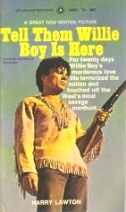The Willie Boy StoryCarlota, the daughter of William Mike, a Twenty-nine Palms Chemehuevi who had moved his family to the Gilman Ranch in the Coachella Valley near Banning, figured in a tragedy that rocked southern California in 1909, and has since been the subject of books and a movie. A cousin named Willie Boy, who had fallen in love with her, persuaded her to elope with him, their marriage having been forbidden because they were cousins. Her father tracked them and brought them back. Accounts vary with respect to what followed, but agree that Willie Boy shot and killed William Mike, perhaps by accident, escaped with Carlota into the desert, was tracked by a posse, and left Carlota hidden in a wash with his coat and waterskin. She died, either shot by the posse by mistake, or from exposure. According to Chemehuevi tradition, Willie Boy escaped, but has not been seen again (Trafzer et al. 1997:86-90).
The story of Willie Boy was the basis for Harry Lawton's novel, Willie Boy: A Desert Man Hunt, and a subsequent movie, Tell Them Willie Boy Was Here, starring Robert Redford, Katherine Ross, and Robert Blake. A number of Morongo Indian Reservation members played roles in the movie. More recently, historians James Sandos and Larry Burgess published The Hunt for Willie Boy: Indian Hating and Popular Culture, which incorporated valuable data contributed by Chemehuevis who were familiar with the events.One of those "accounts that vary":
What ever happened to Willie Boy....Willie Boy was a Paiute Indian, uncle to my uncle Leroy Arnize (Arnesto in Spanish) who in 1909 ran off with his lover after killing her father in self defense.Why Willie Boy is in the news again:
Historian follows legend of Willie Boy“To the victor belongs the story,” Paul Smith told about 75 people assembled at the Hi-Desert Nature Museum on Wednesday, March 4 for a lecture about the Willie Boy manhunt that took place throughout the Morongo Basin 100 years ago.The context of the manhunt:
With his wife, Jane, Smith owns and operates the 29 Palms Inn at the Oasis of Mara. Willie Boy went there following the homicides of William Mike, also known as Mike Boniface, and later his daughter, variously known as Isoleta or Carlota.
Smith described a culture of fear fueled by ignorance a century ago of American Indian spirituality, their rituals and what Euro-Americans considered their savage living habits and conditions.
The Willie Boy manhunt occurred in October 1909, only 33 years after the Indian massacre of U.S. Cavalrymen at Little Bighorn. Fear of an Indian uprising was exacerbated by an impending visit by President Taft on a sweep through Riverside and San Bernardino counties, Smith explained. The Chemehuevi Indians left their Twentynine Palms oasis home reluctantly but voluntarily after the Willie Boy incident to avoid further problems with the white settlers.Comment: For more on the subject, see
The Best Indian Movies.



No comments:
Post a Comment
Note: Only a member of this blog may post a comment.